0136
Yvonne C. Bain*
School of Education, University of Aberdeen, Aberdeen, UK
Abstract
Online learning, often supported through online discussion, is not only a popular means of supporting off-campus learners, but increasingly has a place within campus-based learning courses. Laurillard and others suggest that there are assumptions being made about learning through online discussion that have yet to be fully tested, and therefore there is a need to examine this area further. Tutors and learners may benefit from having a greater insight and understanding of how engaging in asynchronous online discussion presents opportunities for learning on an individual and a collective basis. This research study focused on learners’ engagement with online discussion and their perceptions of how engaging in online discussion impacts on learning. This paper revisits learning through online discussion and proposes a framework, which emerges from the analysis of learners’ experiences. A grounded theory approach was used in the collection and analysis of six learner case studies within a higher education setting, exploring learners’ interactions in online discussion, and their perceptions of learning through online discussion. Insights into the learners’ interactions were provided by the learners themselves through semi-structured interviews. The grounded approach to the analysis of the interviews enabled the learners’ voices to be heard in terms of what they thought about learning through online discussion. The insight enabled through the depth of description from the learners and the examination of the online interactions led to the development of a framework for learning through online discussion. The framework raises the importance of articulation as a key process in learning whilst highlighting the opportunities for collaborative informed thinking by engaging with the ideas of others. The focus given to the learning process through the framework will be of interest to tutors and learners who use online asynchronous discussion environments for learning.
Keywords: Computer Mediated Communication; learners experiences; asynchronous discussion; grounded theory
*Corresponding author. Email: y.c.bain@abdn.ac.uk
(Received 14 June 2011; final version received 22 June 2011; Published: 31 August 2011)
ISBN 978-91-977071-4-5 (print), 978-91-977071-5-2 (online)
2011 Association for Learning Technology. © 2011 Y.C. Bain. This is an Open Access article distributed under the terms of the Creative Commons Attribution-NonCommercial-NoDerivs 2.0 UK: England & Wales licence (http://creativecommons.org/licenses/by-nc/3.0/) permitting all non-commercial use, distribution, and reproduction in any medium, provided the original work is properly cited.
DOI: 10.3402/rlt.v19s1/7779
The potential of computer mediated communication (CMC) as a means of enabling interactions and sharing of ideas between learners, wherever and whenever the learner is situated, has been extolled for more than two decades now.
“CMC has the potential to provide a means for the weaving together of ideas and information from many people's minds, regardless of when and from where they contribute.” Kaye (1989, 3)
However, these benefits are not always realised by learners and there is much still to know about learning within an online discussion environment, as has been identified in other studies such as Downing et al. (2007) who recognise the need to know more about effectively supporting and sustaining learner engagement in online environments. Peters and Hewitt (2010) note that there is a need to know more about the online behaviours of students in asynchronous discussion and a need to focus more on learning outcomes. The need to know more about learning, and the experiences of learning, in online discussion is highlighted within this paper.
The paper reports on a qualitative, phenomenographic study which focuses on six learners’ experiences in a Higher Education setting in Scotland, within two different subject disciplines. A grounded approach to analysing the learners’ interactions and their perceptions of their experiences, offers an insight of learning in these discipline settings. The findings from the study led to the development of a framework for learning through online discussion. The proposed framework draws together the experiences of the learners with insight available within research literature about learning through the processes of writing, as may be applicable to posting messages in an online discussion environment. Implications for tutors and learners in asynchronous discussion are discussed.
Mayes and de Freitas (2007), and more recently Laurillard (2009), expressed the view that there is nothing new to know about learning, with the implication that what is known about traditional modes of learning will transfer to learning in online environments. Despite the increasing availability of guidelines relating to tutoring online (e.g. Salmon 2000; Laurillard 2002; Garrison and Anderson 2003), the guidance offered does not seem to transfer into consistent approaches to learning online. McConnell (2006) highlights that not all learners are enthusiastic about engaging in online learning. Other studies raise other issues in relation to the use of learning through online discussion, such as some learners not having the skills required to work in collaborative social constructivist environments (Murphy et al. 2005). Sharpe et al. (2006) and Ellis et al. (2007) caution that some students do not know how to engage effectively in face-to-face discussion and that this may impact on them being able to benefit from the online discussion. Kim and Bateman (2010) likewise consider that there is a need for students to be helped in developing skills to engage with discussion. Therefore, tutors need to know more about supporting online discussion, and there is a need to understand more about learners’ engagement with online discussion, as suggested by Ravenscroft (2005) and Goodyear and Ellis (2008).
Engaging in asynchronous discussion potentially benefits learners by enabling them to take time to reflect on messages previously posted before making their own contribution. Browne (2003) and Macdonald (2006) consider that the time delay affords thinking time. Others such as McConnell (2000) and Andrews and Haythornthwaite (2007) highlight that the permanent nature of the messages posted provides opportunities to reflect on the messages as and when required by the learners. However, the extent to which message posts are actually used for reflection is questioned by Ellis et al. (2007). The potential benefits of learning through online discussion are well documented but not always evidenced in practice, and current research suggests that there is a need to know more about how learners actually spend their time online. Gilbert et al. (2007) and So (2009) call for further research about student interaction in online environments.
However, further consideration needs to be given to the nature of online discussion in that it is neither like oral discussion nor individual writing. Andrews and Haythornthwaite (2007) draw attention to the differences in modes of communicating in an asynchronous discussion environment, citing Erickson (1999) who considered online discussion to be sometimes like formal published text and at other times to be like informal chat. The text-based medium of online discussion creates opportunities for enhancing learning by engaging in writing as a process of learning. Bereiter and Scardamalia (1987) consider that the act of composing helps to shape and develop understanding whilst writing, if the writing is consciously reviewed whilst composing. Ritchhart and Perkins (2008) further consider that the process of articulation or externalising thinking either by writing or by talking helps deepen thinking. In asynchronous discussion, there is an opportunity to use writing to articulate thoughts and therefore externalise thinking for others, and to respond to the thinking that is articulated by others. Mercer (2000) suggests that group interactions, which are as a result of paying attention to others’ contributions, create opportunities for collective, shared thinking in which the individual thinking of a learner may be shaped by engaging with the thinking of others.
Therefore, there is recognition within the literature on the process of writing to shape thinking, and for individual thinking to be informed by collective thinking. However, the possible lack of skills to engage in discussion or the lack of attention to the messages posted by others means that the opportunities are not fully understood or recognised by learners.
The study reported in this paper aimed to explore how learners engage with online discussion. In particular, the study sought to examine the approaches used by the learners and their perceptions of learning with others within an asynchronous discussion environment. The learners were studying at an undergraduate level within a higher education institution in Scotland and from two different subject disciplines. A total of six learner case studies informed the research. Three learners were studying a Scottish Degree level 3 (third year) History of Art campus-based blended learning course; two learners were studying a Scottish Degree level 2 (second year) online Theology course and one learner was studying a first year online Theology course. All six learners were female with a range of prior educational experience.
The History of Art courses were taught on campus but had an online discussion component in the form of a virtual seminar which contributed 20% of the total course assessment. During the online component of the course, the usual class contact time was suspended for a period of two weeks. Learners engaged in discussion about a given virtual seminar topic in groups of four learners. Each learner in the group had a different topic for which they had to write a 2000-word essay prior to the start of the virtual seminar. The essay had to be uploaded in the form of a web page making it publicly available to the others in the group. Learners were explicitly told to engage in the online discussion as an interview format, by asking a minimum of three questions about their peers’ essays and responding to questions asked of them within 72 hours. Within these guidelines, they could engage in the discussion wherever and whenever was suitable to them. The learners undertook this course as part of an honours degree in History of Art. As this was the third year of study in this discipline setting, they were used to engaging in oral discussion within campus-based seminars, and writing about History of Art, but this was the first time that the learning experience required engagement in asynchronous online discussion.
The Theology courses were totally online, and had no campus-based learning component. The course learning materials were available within the online environment. There were six different topics in which the learners were expected to engage in discussion for a period of two weeks per topic. In the first week the asynchronous discussion of the topic was within a small group. In the second week the groups then contributed to a whole class asynchronous discussion. Each learner was at a geographical distance from the campus and was studying the course as part of a Certificate, Diploma or Degree in Theology. Each of Theology case studies was a mature learner and had used online learning and asynchronous discussion in a previous course, with the same tutor and with the same organisation of the learning environment and the learning activities. Engagement in the online discussion for the Theology courses was not compulsory. However, participation in the online discussion was clearly expected. The course study guide highlighted that the learners were to engage with each other and to contribute to the online discussion, and noted that each learner would take on the task of summarising the group discussion at the end of a week.
Case studies were selected from learners who had agreed to have their interactions tracked and had been interviewed about their perceptions of learning through online discussion. Preference was given to learners who were in the same online discussion group. The three History of Art case studies were drawn from a class of 24 learners. In the Theology settings, the three case studies were self-selecting as they were the only volunteers from two classes (of a total of 15 learners).
The researcher was an observer of the online interactions and had no tutoring role in either of the discipline settings. The setting for the study was naturalistic (Gubrium and Holstein 1997) as the data were gathered from the online discussion areas, which were part of the intended course learning processes for the learners. There has not been any attempt to try to impose a particular structure or approach to the online discussions to satisfy a research requirement.
The research study aimed to examine the learners’ perspective of their experience of online discussion and how they engage with online discussion. This required a qualitative research methodology which, in this study, takes a phenomenological and interpretative approach to the analysis of semi-structured interviews with the learners. In order to do so, the study adopted a grounded approach to deriving a theory from the data (Glaser and Strauss 1967). A case study approach (Yin 2003; Stake 2006) was used to focus on the individual learners, to gather in-depth data about the learner and her experiences of engaging in online discussion.
Data were gathered from one institution, two different discipline contexts each with a different mode of delivery of learning, and from three different learners in each of the discipline contexts. Participants were invited to take part in the research before the online discussion activity took place. For each case study, tracking tools available within the WebCT online environment were used to gather data about the learner's online interactions; discussion posts were captured to explore the nature of the contributions made; and a semi-structured interview was used to gain insight to the learner's perceptions of her engagement in, and with, asynchronous discussion. The interviews took place after the discussion activity was completed and made use of the tracking detail to prompt recall of activity and discussion of the online interactions. Visual timelines of interactions were manually created (see Figures 1 and 2). Gibbs et al. (2006) have created a tool for online discussion which will generate visual timelines, but this was not used in this study.
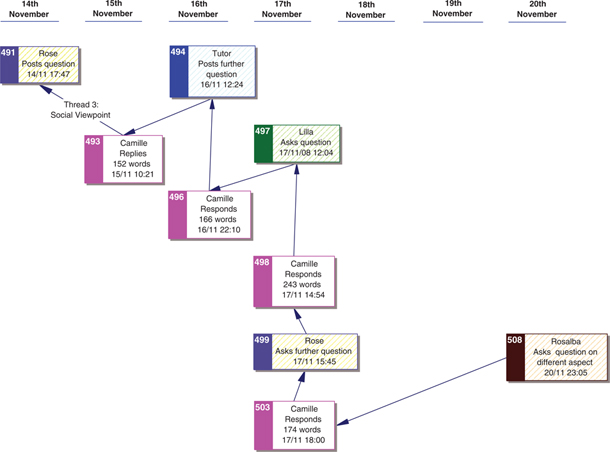
Figure 1.
Visual timeline of Camille's interactions.
The grounded approach to analysing the interviews highlighted themes within students’ comments in relation to the need to articulate clearly for others; engaging with the ideas of others; temporal aspects of using the time delay to research and prepare responses; and the impact of assessment for example. An iterative process was involved in creating the framework by examining the interview statements, exploring the interactions that took place, making connections between students’ perceptions and their online behaviours, and reconsidering what could be understood about the learning processes from the research literature.
The tracking data revealed differences in how learners engaged with each other in the online discussion environment. A visual timeline was created to show the pattern of interactions. For example, in the History of Art contexts, two of the case studies, Camille and Rosalba (pseudonyms) regularly logged on to the learning environment, but had different time-scales for engaging with others.
Camille was shown to respond regularly within 24 hours of questions being asked of her, as shown in Figure 1, which shows the date and time of posting of a particular message (number), and the length of response given (words) for two of the discussion threads.
Rosalba chose to delay her responses as shown in Figure 2. This resulted in a more restricted engagement with her peers as there was very little time left for peers to ask anything further about the responses given by Rosalba. The pattern of interaction in Rosalba's discussion forum shows a pattern of question–answer only with no follow-up, whereas Camille's interactions show a more extended question–answer engagement with the interactions in the third thread Figure 1, Thread 3: Social Viewpoint). Rosalba's experience supports the views expressed by Jeong and Frazier (2008) and Dringus and Ellis (2010) that late posts are less likely to receive a response, as can be seen in Figure 1 when the late post by Rosalba does not receive a response from Camille.
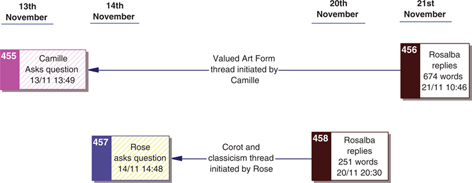
Figure 2.
Visual timeline of Rosalba's threads 2 and 3.
Further insight was gained from the semi-structured interviews with the learners, which revealed for instance that Rosalba was unaware of restricting her opportunities for engaging with others. Her perception was that the time delay allowed for further research on a topic and that “you're more likely to sort of interact and have a longer sort of discussion about something”. She also made reference to the convenience of being able to engage in discussion as anytime-anywhere learning (Hiltz and Goldman 2005), commenting that:
They are more likely to get involved because you don't have to turn up anywhere really I mean you could just sit in bed and do it. … if you've got something else to do you can go and do it and it's learning in your time. [Rosalba]
Rosalba's perceptions of engaging with others did not necessarily match up with the reality of her engagement with others.
The History of Art online discussions formed part of the course assessment and that may have impacted on how the learners interacted with each other. Rosalba and other learners commented on engaging with others because it was assessed and they wished to get a good mark. Marguerite for example noted that:
people want to get the best marks they can and I think that probably shapes how people do things. [Marguerite]
However, the assessment was not necessarily enough of a motivator for all participants, as in one discussion forum it was observed that three learners did not engage with the fourth member of the group.
In the Theology course settings, there was no compulsion to participate and no assessment of the online contributions. In the Theology settings, there were very low levels of interaction between learners. The lack of engagement with others meant that a sense of frustration developed as learners realised that this could have impacted on their learning. For example, in the level 2 course, Martha noted her frustration at the lack of interaction by others:
I found it very frustrating.. the lack of input from people, so whenever there was a contribution, I would have replied to it. [later in the interview] I think I could have got more out of it if, other people had contributed a bit more... I was a bit frustrated that folk didn't take part. [Martha, level 2 Theology]
Ruth for instance, relied on interacting with the tutor mainly. In her interview she too commented on the lack of presence of other learners:
I felt sometimes, you were putting your answers and you were almost, well, forgetting about the others that were there. [Ruth, level 1 Theology]
This was clearly not the level of interactive discussion that the tutor had planned for the course.
The lack of response, or delayed response, was experienced in both disciplines and impacted on learners in different ways. In the Theology course, Martha commented on realising that the lack of engagement may have impacted on what she could have learned. In the History of Art course, Camille commented on losing her thought processes when peers did not respond in a timely manner:
There was one person in my group who I answered I asked two questions and it was about four of five days before they bothered to reply which was a bit annoying because by the time when I went back to read their thing I'd forgotten what my first thought was. [Camille, History of Art]
Her comment is a reference to the interactions shown in Figure 2, in which Rosalba takes several days to respond.
The interactions of learners were not necessarily matched with the learners’ perceptions of how they engaged with other. The negative impact that the lack of engagement can have suggests that for small group discussion there is a need to ensure that all are actively involved. Studies, such as Romiszowski and Mason (2004) and Beaudoin (2005), highlight that lurkers (those who read messages but do not post) are engaged in learning through reading the contributions of others. However, the potential impact of their lack of overt engagement should be noted.
In the interviews the learners commented on broadening and deepening their understanding of a topic within their subject discipline. For instance, Camille commented that her engagement with others in the discussion area and with reading other people's essays helped her broaden her thinking about her own essay. Marguerite spoke of developing a more critical approach to examining someone's work as a result of reading her peers’ contributions. Marguerite considered that her engagement in the discussion, and the questioning of her peers, and articulating her thoughts for others helped clarify her understanding about a topic. Marguerite (in History of Art) and Martha (in Theology) each raised the aspect of writing for an audience, being aware that their responses would have to be constructed carefully to try and get an argument across without misinterpretation by others which helped articulate their thinking.
Whilst there are contradictions in the literature about whether the participants of asynchronous discussion actually use the time delay for reflection, there was evidence of reflection in these case studies. Reflection was implied by Camille, who made reference to having time to collect her thoughts; whilst Ruth (in Theology) spoke of using time to reflect on reading. The learners benefited in some way by engaging in reflection, by taking time to shape and develop their messages and in articulating their thoughts for others to understand.
From the learners’ experiences, it seems that there is a need for learners to understand more about the processes involved in learning through online discussion so that they can maximise the opportunities that are presented. There are opportunities to develop learning through online discussion, but these are not fully recognised or acted upon by learners. Drawing from the learners’ experiences and the literature, a framework for learning through online discussion emerges.
The learners provided evidence of making use of the asynchronous nature to reflect and to think some more about the topic of discussion in order to further shape their understanding of the topic. These activities are covert activities, not evident to others unless some tangible output of this is shared with others. Figure 3 represents the hidden (covert) processes involved.

Figure 3.
Covert processes.
As identified by the learners, there are benefits to be gained from articulating their thinking for others to read. The act of writing can help develop understanding of the subject itself (Bereiter and Scardamalia 1987; Mercer 2000). Figure 4 highlights the role of articulture in learning.
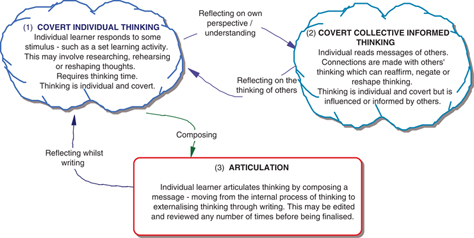
Figure 4.
Articulation as a process of learning.
When a learner chooses to post a message, she/he may choose to make overt connections with the thinking of others by making a response which has connections with the previous messages posted and adding to the thread of discussion (e.g. as happened in Camille's interactions in Figure 1. Alternatively, a message may be posted that has no connections with other messages, and is posted as an isolated, unconnected message Figure 5 represents the overt articulation which occurs when posting a message.
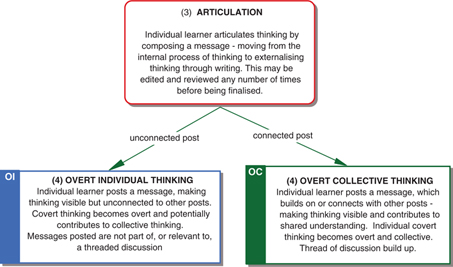
Figure 5.
Overt articulation.
Figure 6 highlights the potential benefits to an individual learner from being informed by others through reading and reflecting on the messages posted by others, from composing a written response and articulating thinking to make thinking ‘visible’ to others (Ritchhart and Perkins 2008).
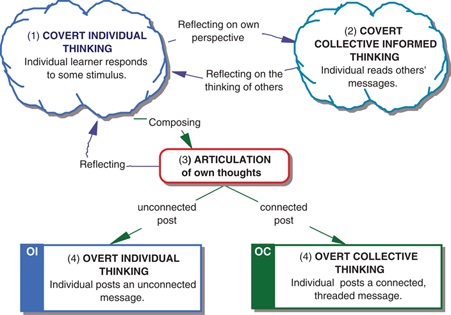
Figure 6.
Individual learning opportunities created through online discussion.
This is not a one-way process, however, and just as an individual can be informed by the contributions of the group, the individual can inform the thinking of others in the group, potentially building up collective thinking. The individual's learning may be prompted by, and contribute to, the thinking of others if she/he chooses to read and take account of the messages posted by others. Thus, there are reciprocal learning opportunities for an individual and for the others in the group. Figure 7 summarises this reciprocity of learning opportunities created when learners engage in learning through online discussion. The top half of the figure represents the opportunities for an individual learner whilst the bottom half represents the opportunities of others that arise as a result of their articulation of thinking and their reflections of the contributions made by other individuals. Thus all learners have the opportunities to benefit from the thinking of others, and from articulating their own thinking.
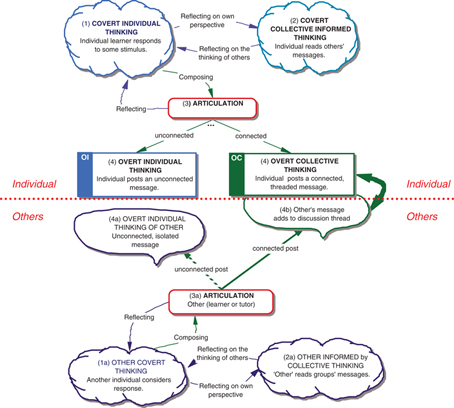
Figure 7.
A framework for learning through online discussion.
Articulation is at the heart of making thinking known to others. Articulation of thoughts may be connected with the thinking of others (overt collective informed thinking) when the message posted draws from, or is openly influenced by, the messages of others. Articulation may be unconnected to others (overt individual thinking) exemplifying individual thinking shown as isolated posts. To move from individual thinking to collective, shared thinking requires the individual learners to read, reflect and make connections which are then articulated in messages posted. The overt articulation of thinking creates possibilities for individual thinking to develop into new, collective and shared thinking.
Mercer (2000, 129) cautions that: “CMC will only be as good for collective thinking as its users make it”. If learners are not fully aware of the opportunities for developing learning through CMC then the result may be a lack of overt engagement which impacts on the individual and other learners in the group.
This study is limited in that none of the case studies focused on a male participant and none of the case studies focused on a non-contributor to online discussion. Further, it may be that the learners’ interactions have been influenced by the non-participating presence of the researcher, although there was no evidence to suggest that this was so. The lack of inclusion of learners who chose not to contribute to the online discussion does not invalidate the analysis of the case studies, but rather highlights that this is an aspect that would be worth following up in further studies. It may be particularly helpful to explore the relevance of the framework for learning through discussion for non-contributors and to gain insight into their reasons for not contributing to online discussion.
The case studies provide an insight into learners’ approaches to online discussion, the strategies that they use, their reactions to engaging with others and their perceptions of learning through discussion that is not readily available in other research studies.
The framework for learning through online discussion which emerged from the reconsideration of the processes, as identified by the learners and related to in the literature, highlights the importance of articulation as part of the learning process and the importance of building on the contributions of others. In the two discipline settings within this study, the tutor had designed activities specifically intended to engage learners in online discussion, but in both settings there were limitations to how learners chose to engage in this. Tutors need to be explicit about the rationale for including online discussion as part of the learning experiences, not just in terms of noting expectations of frequency of posting or desired response times, but in terms of what is meant by discussion and how discussion is expected to develop as the learning activity progresses. Tutors should explain to learners why online discussion in the form of written contributions may be helpful in terms of developing thinking and moving from an individual perspective to a collective informed perspective or shared perspective.
The proposed framework for learning through online discussion provides an alternative perspective to the Conversational Framework of Laurillard (2000), by focusing on the learner engagement rather than the tutoring role, and by raising the essential role of articulation in learning through online discussion, without which thinking cannot be shared and feedback (which is a key aspect of Laurillard's framework) cannot be provided.
Further development of the framework might provide a means of using the framework for learners’ self-analysis or tutor-analysis of engagement with the learning opportunities. It is possible for the framework to be used as the basis of evaluative questions which encourage learner and/or tutor reflection on the covert processes of engaging with discussion, the overt processes of engaging in discussion, and the manner of articulation. It may be possible for further research to share the framework with the learners and tutors, and to then use that as a basis for examining the learning experiences.
Whether having an understanding of learning through online discussion expressed in this way is helpful for tutors and/or learners in terms of supporting and developing their use of online discussion remains for further research.
Andrews, R., and C. Haythornthwaite. 2007. Introduction to e-learning research. In The sage handbook of e-learning research, ed. R. Andrews and C. Haythornthwaite, 1–52. London: Sage Publications Ltd.
Beaudoin, M. 2005. Reflections on seeking the ‘invisible’ online learner. AECT 2005. http://www.Learndev.Org/Dl/Ibstpi-Aect2005-Beaudoin.Pdf (accessed September 17, 2010).
Bereiter, C., and M. Scardamalia. 1987. The psychology of written composition. Hillsdale, NJ: Lawrence Erlbaum Associates, Inc.Browne, E. 2003. Conversations in cyberspace: A study of online learning. Open Learning 18, no. 3: 245–59. [Crossref]
Downing, K.J., T.-F. Lam, T. Kwong, W.-K. Downing, and S.-W. Chan. 2007. Creating interaction in Online learning: A case study. Alt-J 15, no. 3: 201–15. [Crossref]
Dringus, L.P., and T.J. Ellis. 2010. Temporal transitions in participation flow in an asynchronous discussion forum. Computers & Education 54: 340–9. [Crossref]
Ellis, A.R., P. Goodyear, A. O'hara, and M. Prosser. 2007. The university student experience of face-to-face and online discussions: coherence, reflection and meaning. Alt-J-Association for Learning Technology Journal 15, no. 1: 83–97. [Crossref]
Erickson, T. 1999. Persistent conversation: An introduction. Journal of Computer Mediated Communication 4, no. 4 JCMC http://jcmc.indiana.edu/vol4/issue4/ericksonintro.html (accessed September 17, 2010).
Garrison, D.R., and T. Anderson. 2003. E-learning in the 21st century a framework for research and practice. Oxon: RoutledgeFalmer.Gibbs, W.J., V. Olexa, and R.S. Bernas. 2006. A visualization tool for managing and studying online communications. Educational Technology & Society 9, no. 3: 232–43.
Gilbert, J., S. Morton, and J. Rowley. 2007. E-learning: The student experience. British Journal of Educational Technology 38, no. 4: 560–73. [Crossref]
Glaser, B., and A. Strauss. 1967. The discovery of grounded theory strategies for qualitative research (Observations). London: Weidenfeld and Nicolson.Goodyear, P., and R.A. Ellis. 2008. University students' approaches to learning: Rethinking the place of technology. Distance Education 29, no. 2: 141–52. [Crossref]
Gubrium, J., and J. Holstein. 1997. The new language of qualitative method. NY: Oxford University Press.Hiltz, S.R., and R. Goldman. 2005. What are asynchronous learning networks? In Learning together online research on asynchronous learning networks, ed. S.R. Hiltz and R. Goldman, 3–18. London: Lawrence Erlbaum Associates.
Jeong, A., and S. Frazier. 2008. How day of posting affects level of critical discourse in asynchronous discussions and computer-supported collaborative argumentation. British Journal of Educational Technology 39, no. 5: 875–87. [Crossref]
Kaye, A. 1989. Computer-mediated communication and distance education. In Mindweave: Communication, computers and distance education, ed. R. Mason and A. Kaye, 1–21. Oxford: Pergamon Press.
Kim, H.K., and B. Bateman. 2010. Student participation patterns in online discussion. Incorporating constructivist discussion into online courses. International Journal on E-Learning 9, no. 1:, 79–98.
Laurillard, D. 2002. Rethinking university teaching a conversational framework for the effective use of learning technologies 2nd ed. Abingdon, Oxon: Routledgefalmer.Laurillard, D. 2009. The pedagogical challenges to collaborative technologies. Computer Supportive Collaborative Learning 4: 5–20. [Crossref]
Macdonald, J. 2006. Blended learning and online tutoring. Aldershot: Gower Publishing Limited.Mayes, T., and S. De Freitas. 2007. Learning and e-learning: The role of theory. In Rethinking pedagogy for a digital age designing and delivering e-learning, ed. H. Beetham and R. Sharpe, 13–25. Oxon: Routledge.
McConnell, D. 2000. Implementing computer supported cooperative learning 2nd ed. London: Kogan Page. McConnell, D. 2006. E-learning groups and communities. Maidenhead: The Society for Research in to Higher Education & Open University Press. Mercer, N. 2000. Words and minds how we use language to think together. London: Routledge.Murphy, K., S. Mahoney, C.-Y. Chen, N. Mendoza-Diaz, and X. Yang. 2005. A constructivist model of mentoring, coaching, and facilitating online discussion. Distance Education 26, no. 3: 341–66. [Crossref]
Peters, V.L., and J. Hewitt. 2010. An investigation of student practices in asynchronous computer conferencing courses. Computers & Education 54: 951–61. [Crossref]
Ravenscroft, A. 2005. Towards highly communicative e-learning communities. In Education in cyberspace, ed. R. Land and S. Bayne, 130–45. Abingdon, Oxon: Routledgefalmer.
Ritchhart, R. and, D. Perkins. 2008. Making thinking visible. http://www.Pz.Harvard.Edu/Vt/Visiblethinking_Html_Files/06_Additionalresources/Makingthinkingvisibleel.Pdf (accessed July 27, 2010).
Romiszowski, A., and R. Mason. 2004. Computer-mediated communication. In Handbook of research on educational communications and technology. 2nd ed. D. Jonassen, 397–431. Association for educational communications and technology: http://www.Aect.Org/Edtech/15.Pdf (accessed August 9, 2010).
Salmon, G. 2000. E-moderating the key to teaching and learning online. London: Kogan Page Limited.Sharpe, R., G. Benfield, G. Roberts, and R. Francis. 2006. The undergraduate experience of blended e-learning: A review of UK literature and practice. The Higher Education Academy. http://www.Heacademy.Ac.Uk/Resources/Detail/Ourwork/Teachingandresearch/Undergraduate_Experience (accessed July 09, 2010).
So, H. 2009. When groups decide to use asynchronous online discussions: collaborative learning and social presence under a voluntary participation structure. Journal of Computer Assisted Learning 25, no. 2: 143–60. [Crossref]
Stake, R.E. 2006. Multiple case study analysis. New York: The Guilford Press. Yin, R.K. 2003. Case study research design and methods vol. 5, 3rd ed. Applied social research methods. Thousand Oaks, CA: SAGE Publications Ltd.